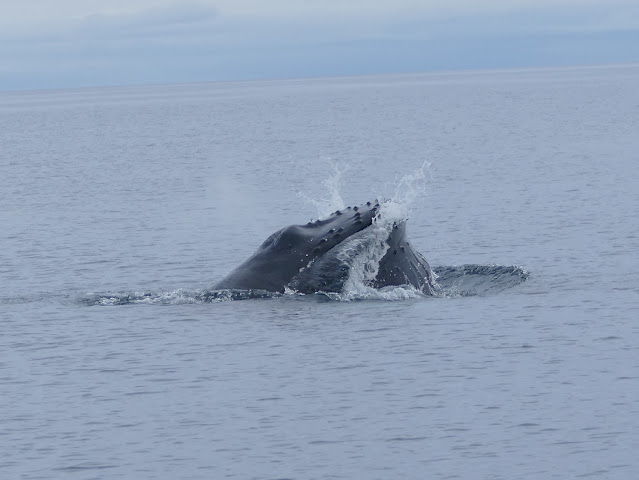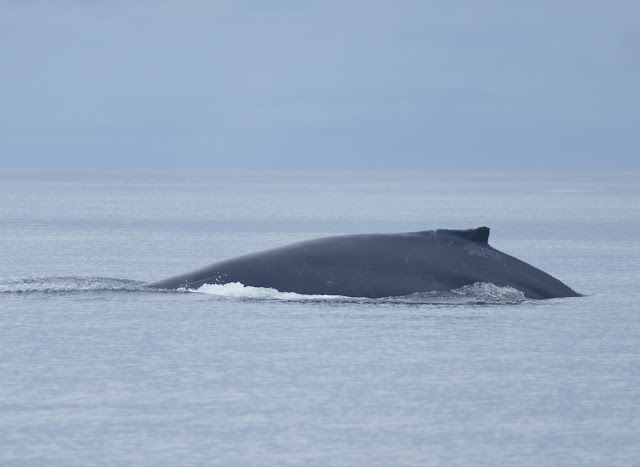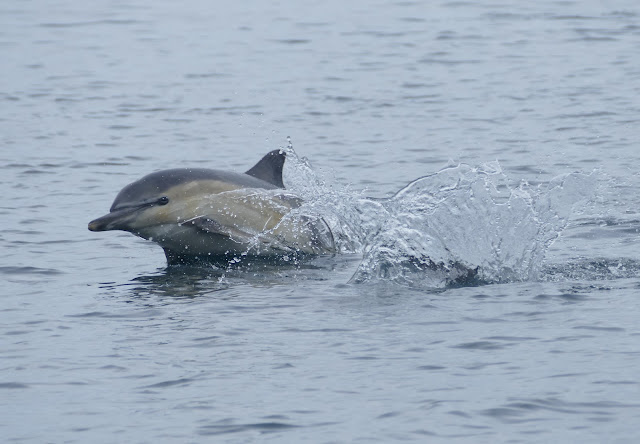I seem to be running out of superlatives when describing whale watching trips
out into the Minch with
Hebridean Whale Cruises (opens in a new window), but once again I can only describe todays
experience as epic.
So far this year most of the large whale action has been just west of the
Summer Isles at the mouth of Loch Broom, with several humpback whales and at
least one fin whale present. These animals can be seen from the ferry and
probably also land, but a dedicated whale watching trip is by far the best way
to get a good look at them. Today we saw three different humpbacks, two of
which were completely new individuals that had not been recorded by anybody
previously.
One of the great things about the whales being in this area is that they are
often seen with the magnificent backdrop of the mountains of Inverpolly. This
is an area which I know well and in the photo above you can see Stac Pollaidh
just left of centre. This is is a hill that I have climbed many times
over the past 40 years,
including last year with Elaine, and I've photographed from all angles but I never thought that I would get
a photo of it like this with a humpback whale diving in front of it!
The first humpback that we saw today was actively feeding on northern krill.
What an incredible experience to witness this at close range! The winds were
light and the sea was as flat as it's ever likely to get here. Suddenly an
area of the sea would turn orange, perhaps no more than 50m in front of us.
At first it was hard to know what was happening but it soon became
apparent.

|
| Photo: Northern Krill © Uwe Kils. |
The orange was actually hundreds of thousands of krill being driven to the
surface by a feeding humpback whale. The whale was lung feeding, which means
that it lunged towards the krill at speed, driving them towards the surface
and in panic and desperation the krill were leaping from the water in a bid to
escape!
Suddenly the humpback emerged from the water with mouth open taking in gallons
of water and hundreds of thousands of krill.
Gradually it closed its mouth trapping the krill behind its baleen plates
which you can see on its upper jaw in this photo.
Here's a close up of krill.
With its mouth shut it's throat is now bulging with water and krill.
The water is expelled through it's baleen plates, trapping the krill so that
they can now be swallowed.
When it's finished it apparently licks it's baleen plates clean with it's
tongue before starting again. Not something that I was able to photograph
though!
We were just floating with the engines off and the whale came right up to us
and even went under the boat. This is it's pectoral fin....
....and here's the rest of it.
Humpbacks can be identified to individuals by the their flukes and to a lesser
extent their dorsal fins which vary in pattern and are a bit like our
fingerprints. This particular whale is a new one that had not been recorded in
this area previously
Notice the rabbit-ear barnacles on the end of the fluke. These don't actually
attach themselves directly to the whale, they are in fact attached to acorn
barnacles which do directly attach themselves to the whale.
This is the second humpback that we saw this evening and if you compare the
dorsal fin with the previous animal, you can see straight away that part of
the fin is missing.
This fluke pattern is very different to the previous whale. This is another
individual that has not previously been recorded.
This is the third humpback of the day. Again you can see that part of the
dorsal fin is missing but it's different to the previous two whales.
I've never seen a fluke as black as this, usually there's a lot more white in
it. This is a whale which has been previously recorded and has been given the
name 'Taylor'. So three different humpbacks today and none of them were
'Davies' which we saw on Monday, making it four different humpbacks in the
same area in the space of five days!
It wasn't all about humpbacks today though. We also saw about six minke
whales.
A feeding minke with a second animal behind.
I find harbour porpoise very difficult to photograph because they're small,
they don't stay up for long, they're not predictable in their movements and
they don't often approach boats. These are about the best I've ever managed.
Common dolphins are always a treat.
Gairloch harbour.
Looking towards Torridon.
What a day!
Today's route.

























































No comments:
Post a Comment